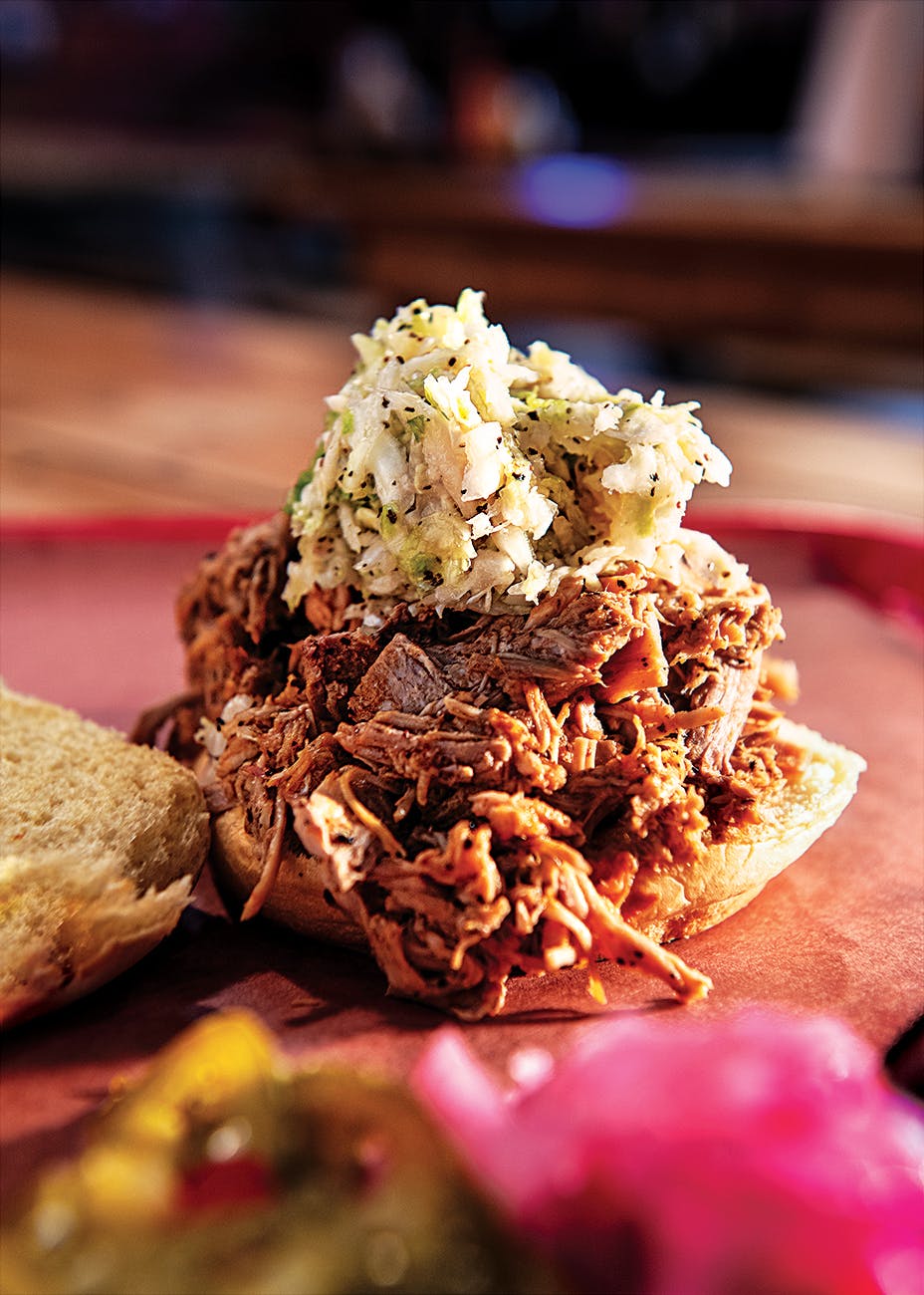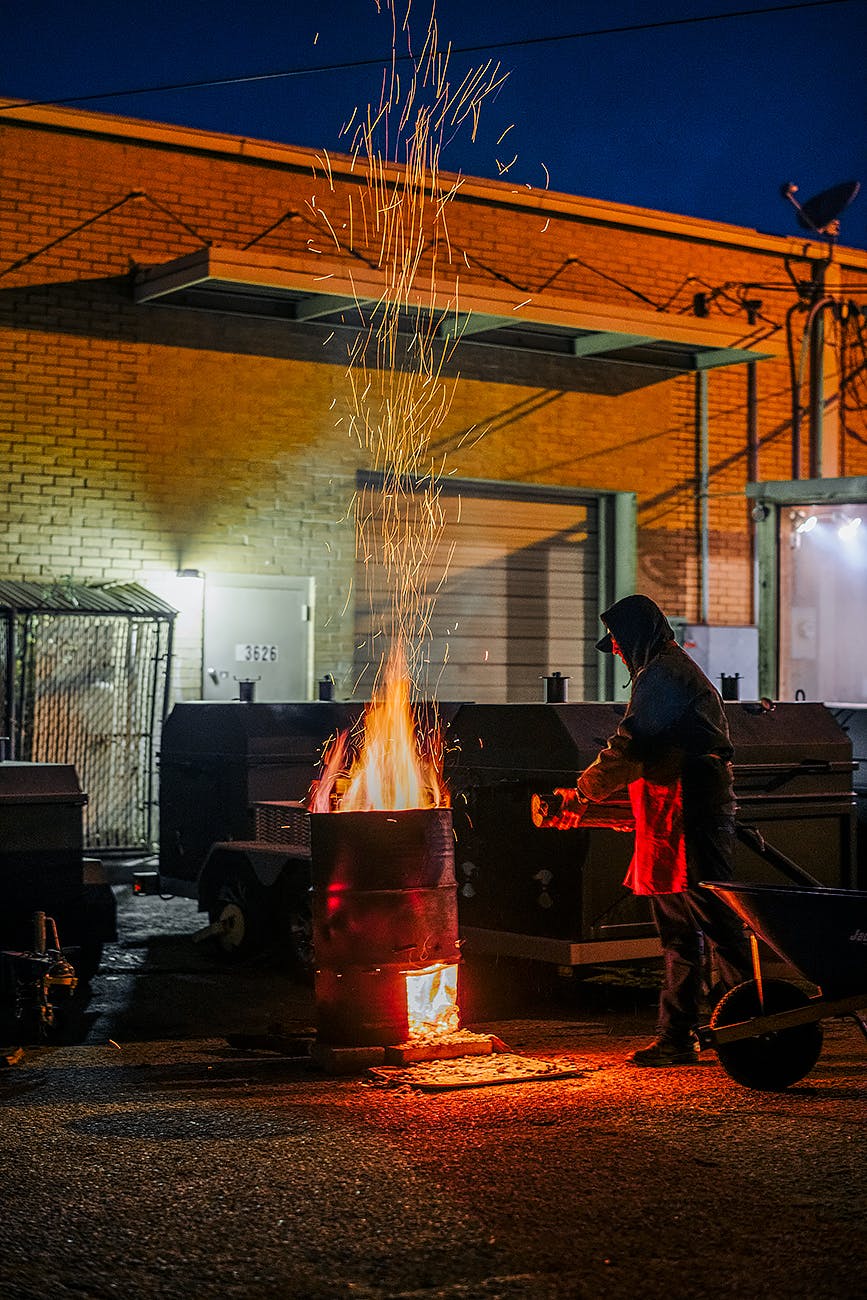The smoke had already cleared when police arrived at Cattleack Barbeque, in North Dallas, on a Saturday morning in March 2015. Owner Todd David was in the back parking lot, peering into his new cooker to assess which parts of the animal inside weren’t yet burnt to a crisp. Minutes earlier, he had accidentally pierced the skin of the pig, which was nearly done cooking, causing hot fat to rain down onto the searing coals below. The smoke from the resulting grease fire caused an alarmed neighbor to call 911. Such was the maiden voyage of his new BQ Grill, designed specifically to cook entire hogs. It was a rough start, but it proved a valuable lesson for a Texas pitmaster who has become something of an evangelist for Carolina-style whole-hog barbecue.
Texas is a proud beef state. We’re often mocked by hogmatics in pork country, especially North and South Carolina, who argue that if it didn’t oink, it’s not barbecue. But despite their dig at our smoked-brisket traditions, I’ve noticed a lot of brisket showing up on menus far from Texas, and that includes the Carolinas. Heck, one of the most-heralded pitmasters to come out of Austin, John Lewis, has swayed the pork faithful with his brisket and beef hot-gut sausages at three-year-old Lewis Barbecue, in Charleston, South Carolina, where a bovine mural demands “All Hail the King.”
Whole-hog barbecue isn’t experiencing the same kind of popularity in Texas, but it has found some ardent supporters. And we’re not talking pulled pork, which on many Texas menus means smoked pork shoulder. Whole hog, as the name implies, is a lot more than the shoulder. It’s the entire animal, with the skin still on, though often without the head and feet. The hog is usually cooked over hot wood coals rather than inside an offset smoker, and when it’s done, all the cuts from the loin to the belly are chopped up together and served.
On hip Rainey Street, in downtown Austin, Banger’s Sausage House and Beer Garden, which opened in 2012, built a new smokehouse in late 2018 devoted to whole-hog barbecue. In the land of Franklin Barbecue, La Barbecue, and Micklethwait Craft Meats, joints are judged by their brisket, which is precisely why Banger’s pitmaster Ted Prater took a different path: He doesn’t offer brisket at all. “Why would I bother trying to compete with any of that?” he asks.
Prater doesn’t copy any one style for his whole-hog barbecue. The steel pits are similar to those used by Rodney Scott, a James Beard Award–winning pitmaster in Charleston. Prater’s technique of chopping crisp skin into the meat and mixing it with a vinegary sauce comes from North Carolina, but he cooks his hogs hotter and faster, which is how it’s done in his native Tennessee. He tops his pork sandwich his own way, with a mustard-based barbecue sauce and a puffy layer of cracklings. It’s unlike any sandwich I’ve eaten outside the state.

A whole-hog sandwich, topped with slaw, at Cattleack Barbeque, in North Dallas.
Another Carolinian inspired David, at Cattleack. Pitmaster Sam Jones, whose family founded the 73-year-old Skylight Inn in Ayden, North Carolina, also runs Sam Jones BBQ, in nearby Winterville. “Sam’s method of cooking made the most sense to me,” David says. The two met a few years ago at the annual Whole Hog Extravaganza, a weekend cooking course and networking event produced by 17th Street BBQ, in Murphysboro, Illinois. There, Jones demonstrated how to patiently and carefully crisp the pig skin until it crackles (David, of course, would later learn the hard way to be careful not to puncture the skin). Jones then incorporated the skin into the pork along with a mix of vinegar and Texas Pete hot sauce.
David does an honorable job replicating the Jones style, right down to using the same BQ Grill that Jones helped design and popularize. The crisp skin gives the hogs cooked by Jones and David a smokier flavor, which might appeal more to Texans accustomed to the smoky bark on brisket.
David, who serves whole hog every Friday and on the first Saturday of each month, says that if he encounters any skeptical customers, they’re usually folks visiting from Tennessee or the Carolinas rather than Texans demanding brisket fealty. “We sell between two and three times as much whole hog on a Friday as we used to sell pulled pork,” David says. It seems clear that whether it’s the reputation, the flavor, or the novelty, whole hog is more marketable than the standard pulled pork in Texas.
In Houston, Patrick Feges puts both whole hog and pulled pork on the menu at Feges BBQ every day. You’d think the two would cannibalize each other, but Feges says the whole hog is “not even competing against the pulled pork. It competes against brisket.”
Feges is a whole-hog pioneer in Texas. In 2014 he was invited to the second annual Houston Barbecue Festival and wanted to stand out. “Everybody was doing brisket,” he recalls, so he built a whole-hog cooker from scratch, effectively turning himself into what back then could have been described as a barbecue rebel. “In Texas, no one knew about whole hog, so I had the opportunity to do it my own way,” he says.
A few years after his first hog, Feges built another pit for a Labor Day whole-animal menu at Austin’s famed barbecue truck LeRoy and Lewis. Pitmaster Evan LeRoy cooked a lamb and a goat, while Feges handled the hog. It was so good, LeRoy made the hog a permanent part of his menu. He had long had an affinity for pork barbecue and always tried to serve at least one cut or another from the heritage-breed hog farm Peaceful Pork, in San Antonio. The LeRoy and Lewis menu is now dominated by pork.
“We just have to figure out different ways to use it,” LeRoy says. That means all the meat, of course, every bit of skin, and all the extra fat that comes with heritage-breed hogs. After he purchases an entire hog, whatever isn’t used from the animal is lost profit. The raw hams go directly to the grinder for house-made sausage. The skin from the ham is dried and then fried into cracklings. The rest of the hog is cooked over direct heat, and the meat is pulled into chunks to be mixed with sauce and fat. Those chunks, both light and dark meat, are noticeable in the final product. Skin from the shoulder and belly is crisped and chopped for sprinkling over the pork just before serving. “We like the different textures,” LeRoy says. The finer bits are saved for making a South Carolina–style pork hash, which is cooked down to a thick gravy and poured over white rice. So much fat comes off these heritage-breed hogs that LeRoy makes refried beans just to use it up. A sampling of all these dishes represents the most thoughtful and delicious whole-hog barbecue platter you can find in Texas and maybe anywhere.

Cattleack’s Andrew Castelan feeds the fire with coals early in the morning on December 19.
Whole-hog pitmasters face challenges other than just getting the most out of an entire pig. It takes a long time to cook and requires an enormous amount of wood; Cattleack Barbeque uses half a cord of wood to cook one pig. Also, briskets have plenty of fat, but it’s considerably less flammable than the pool of fat that collects in a whole hog as it cooks. “If you catch it on fire, good luck putting it out,” warns David. Then there’s the issue of finding staff who understand the cooking method. Prater says, “Probably the hardest thing about doing whole hog in Texas is they get these young men and women who have only run these briskets and stuff.” Finally, you have to find enough customers to eat an entire pig.
The secret of whole-hog barbecue in Texas is that much of it is done half a hog at a time. Whole-hog joints in other states usually specialize in that protein and don’t have brisket, ribs, and sausage competing against it. In Texas, pitmasters have had to get creative. As mentioned, Prater simply doesn’t serve brisket, and David offers whole hog only a few times a month. Feges and LeRoy have it on their daily menus, but they cook only one whole hog a week. Their buddy Elliott Moss, who cooks hogs at Buxton Hall Barbecue, in Asheville, North Carolina, showed them how you can break down a cooked hog, mix it with sauce and plenty of fat, vacuum-seal it, and store it for a few days in the cooler. When they need more hog, they simply dip the plastic bags into warm water and heat the meat up sous-vide style.
The newest entrant into the small group of Texas whole-hog cookers is Russell Roegels, who opened Roegels Barbecue Co., in Houston, six years ago. In July, he and Misty, his wife and business partner, scheduled a road trip through the Carolinas for whole-hog research. After visiting eight barbecue joints in three days, they settled on a preferred style. “The only one where Misty and I said we could have eaten until we got sick was Skylight Inn,” Roegels says. They returned to Texas, bought a whole-hog pit, and announced a monthly whole-hog special at the restaurant.
In November, Roegels hauled that pit to Austin. He served the only whole-hog barbecue in the ten years of the Texas Monthly BBQ Fest. For most of his career, Roegels would have described himself as a barbecue traditionalist. When I ask him why he thought to look so far from Texas for inspiration, he sighs and says, “Some of these young kids can freaking cook, so we’ve gotta do anything we can do to stay relevant.”

